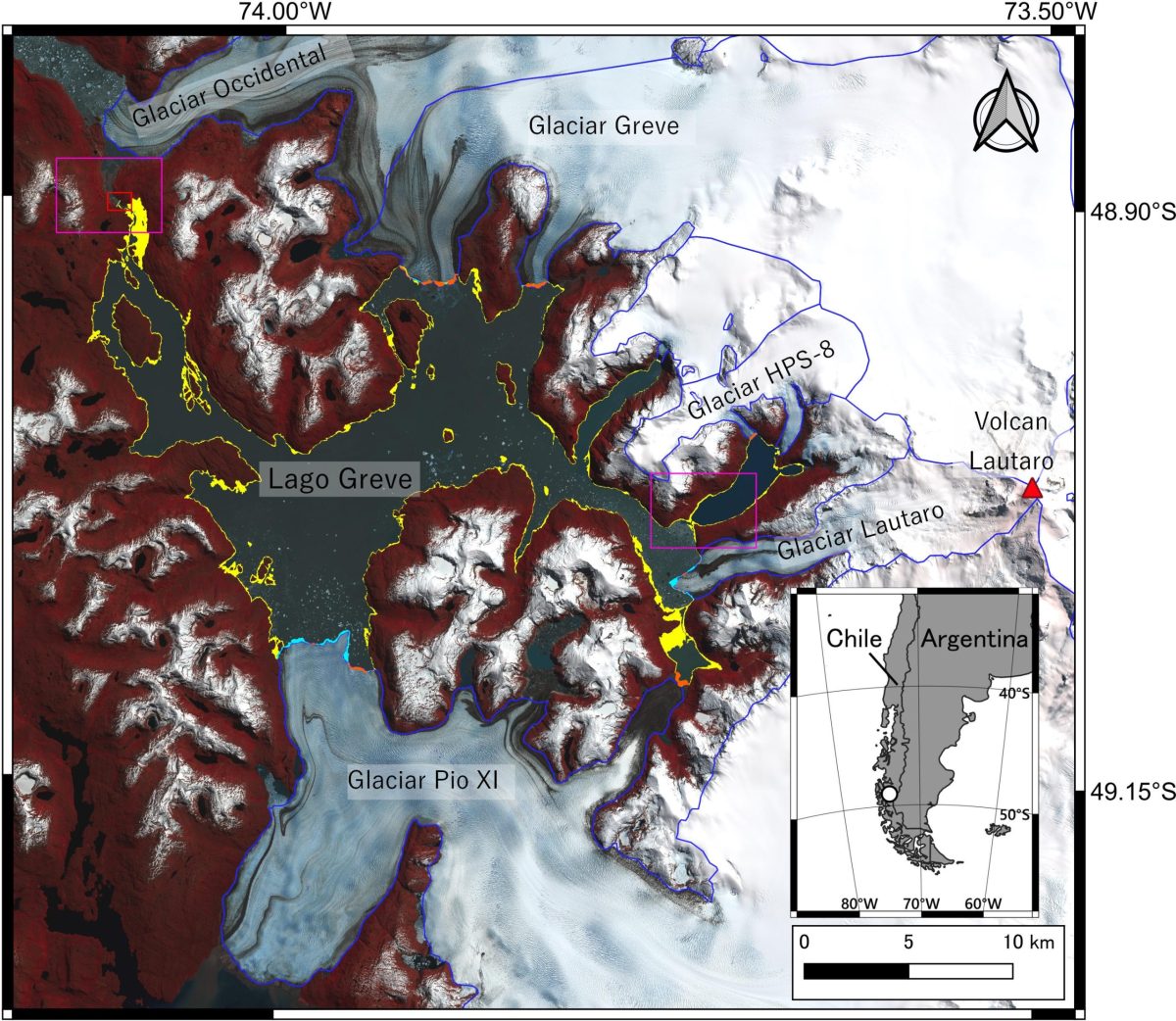Satellite image of Lago Greve (Greve Lake), Chile, and surrounding landmarks. The area which turned from lake to land surface from 8 April to 1st November 2020 is highlighted in yellow. Areas highlighted in orange and cyan indicate the advance and retreat of glacier-calving fronts during the same period. The red box (top right) indicates the location of the lake outlet. Credit: Shuntaro Hata, Shin Sugiyama, Kosuke Heki, Communications Earth & Environment, August 26, 2022
The massive proglacial lake drainage in remote Patagonia was captured by satellites.
Only satellites were around when the fourth-largest proglacial lake in the world suddenly drained in 2020. Researchers from Hokkaido University have recently uncovered the event and examined its source, the collapse of a sediment bump near the lake’s outlet.
Proglacial lakes are created when meltwater from retreating glaciers is held in place by ice or a moraine that was left behind by the same or another glacier. A warmer climate contributes to the recent worldwide rise in the number and volume of these lakes, and they also contribute to glaciers melting more quickly.
These lakes may, however, suddenly drain if the dams keeping them in place fail for a number of different causes. A catastrophic occurrence like this not only endangers human safety directly, but it also has an impact on ecosystems downstream owing to the sudden influx of a lot of fresh water. Therefore, it is crucial to keep an eye on proglacial lakes and research how they interact with their surroundings. Unfortunately, given their often remote location, this is challenging.

The lake area (top) and lake level (bottom) dropped precipitously within the span of 4 months in 2020. Credit: Shuntaro Hata, Shin Sugiyama, Kosuke Heki, Communications Earth & Environment, August 26, 2022.
While researching glacier fluctuations in Chilean Patagonia using satellite pictures, Shin Sugiyama of Hokkaido University and doctoral student Shuntaro Hata discovered that the proglacial lake Lago Greve had significantly shrunk between April and July of 2020.
In their publication of these findings in the journal Communications Earth & Environment, they add further analysis of the available data confirming that the lake’s water level dropped by 18 meters, which translates to a loss of 3.7 cubic kilometers (or, giga-tonnes) of water—the largest such event observed by a satellite to date. This massive loss of water even impacted the Earth’s gravitational field, as recorded by GRACE satellites, although the quantitative data from these satellites is inconsistent with the actual volume of water drained.
Finally, careful analysis of the satellite imagery and topographic data from before and after the event enabled them to deduce that the cause of the release probably was the collapse of a sediment bump close to the outlet of the lake.

Shuntaro Hata (left) and Shin Sugiyama (right), authors of the study, with Matthias Scheiter (center left) and Rodrigo Traub (center right). Credit: Shin Sugiyama.
This study opens up many interesting aspects. For one, it points the way for future research on glacial dynamics. Sugiyama explains: “These results provide detailed information on large-scale glacial lake outburst floods, which occur very rarely, and are important for understanding disasters caused by glacial lake failures.” It also highlights the possibility and the current limitations of using GRACE satellite data for observing such events.
The researchers suggest: “The importance of GRACE measurements in studying such events would be increased if the calculation of the gravity field readings is adapted for localized events.” And finally, the study provides concrete data that can be used to better understand the dynamics of the interactions between glaciers and the lakes they form, as “the observed changes in the water level of glacial lakes can be used to predict changes in the glacier inflow into the lakes.”
Reference: “Abrupt drainage of Lago Greve, a large proglacial lake in Chilean Patagonia, observed by satellite in 2020” by Shuntaro Hata, Shin Sugiyama, and Kosuke Heki, 26 August 2022, Communications Earth & Environment.
DOI: 10.1038/s43247-022-00531-5
Share your story or advertise with us: Whatsapp: +2347068606071 Email: info@newspotng.com












